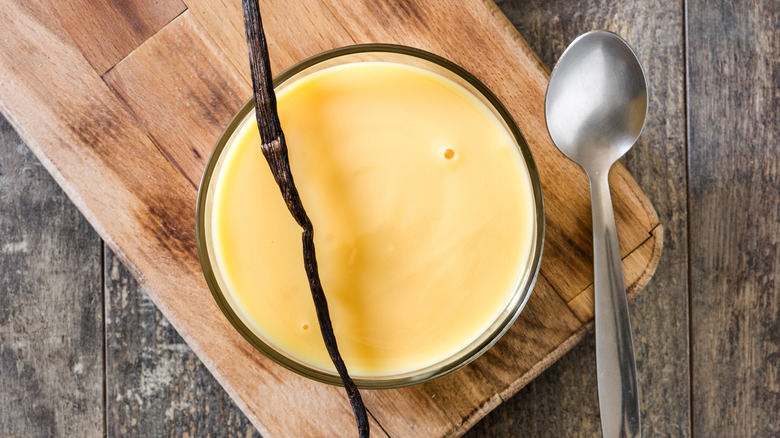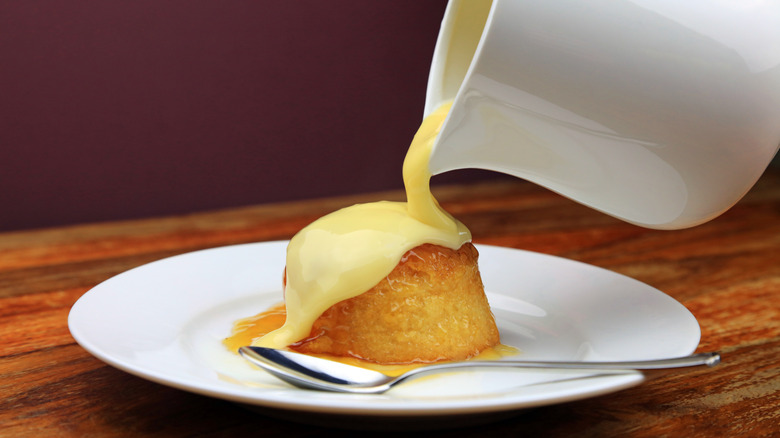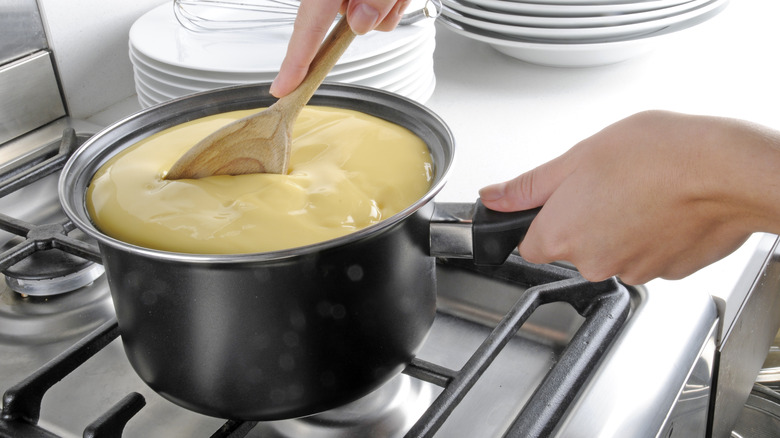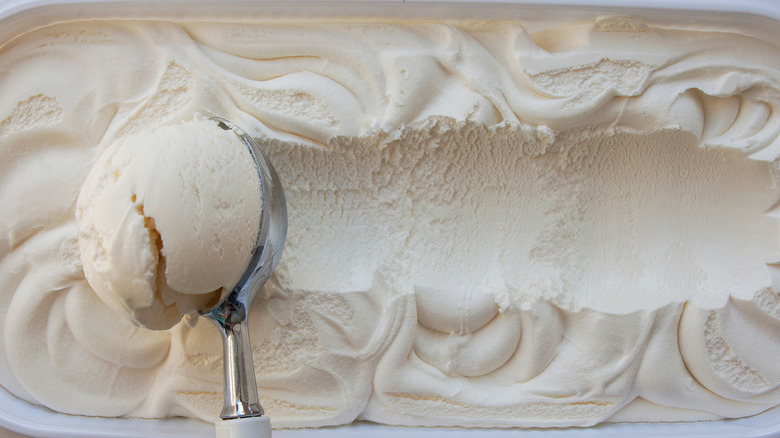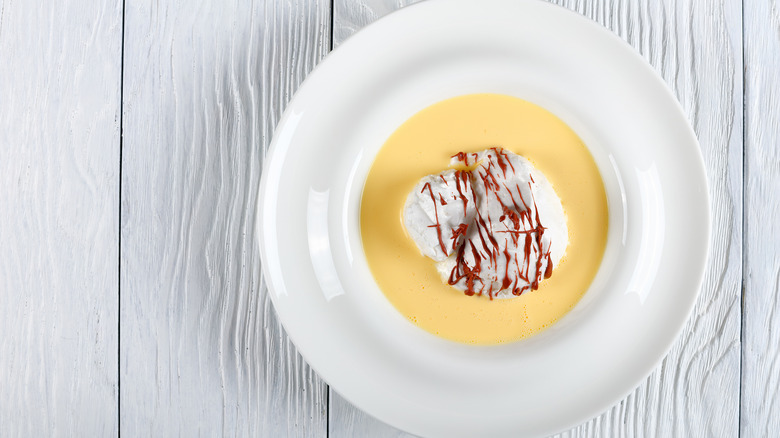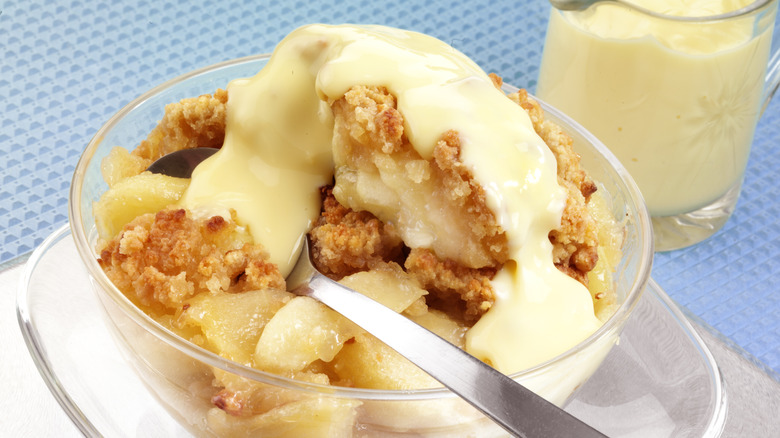What Is Crème Anglaise And How Do You Eat It?
If you grew up eating British food, you probably know what crème anglaise is. You may even have had your fair share of instant Bird's Custard at school, complete with that unappetizing topper of stretchy skin, and cringed at the sight of it. If you were lucky, maybe your mum prepared it from scratch and served it chilled next to a bowl of ripe berries in the hot summer months.
For folks over in the States, crème anglaise, a sweet, vanilla-flavored custard sauce, isn't as common. But if you're obsessed with "The Great British Baking Show," you might remember that crème anglaise made an appearance in an episode back in 2015 that focused on custards (via IMDb). One technical challenge, in particular, was to create Mary Berry's take on a traditional French dessert called île flottante, or floating island. Meringue quenelles are poached, set on a sea of crème anglaise, and topped with a beautiful, crunchy nest of spun sugar, as her BBC recipe explains.
So, we've established an important fact here: The British do indeed love their custards, and crème anglaise is a type of custard. But what else is there to know about this fancy-sounding sauce?
What is crème anglaise?
In its simplest form, crème anglaise is custard, which is prepared by blending milk or cream (and sometimes both) with eggs. The custard is then gently heated, causing it to thicken as the eggs coagulate, per The Spruce Eats. According to Biblical Archaeology, the concept of cooking milk together with eggs to thicken it actually goes back to ancient Rome and the only known cookbook to survive from the period, "On the Subject of Cooking."
There are two types of custards: stirred (sometimes called "boiled") and baked, and they can be made with whole eggs or only the yolks. Baked custards, such as crème brûlée, are prepared in a bain-marie, while stirred custards, like crème anglaise, are made on the stovetop. Crème anglaise, which translates from French to "English cream," is often described as a pouring custard because of its sauce-like consistency that pairs well with cakes and tarts (via The Spruce Eats).
Manuscript Cookbooks Survey points out that even though whole-egg stirred custards were being prepared in the 19th century United States, French techniques had such a stronghold over the world's cuisine that Americans eventually ended up adopting their egg-yolk-only crème anglaise. When the influential Mary Lincoln published her "Boston Cook Book" in 1884, she proclaimed that "boiled custard is much smoother when made only with the yolks of eggs," and that was the end of that.
How do you make crème anglaise?
Because this delicate sauce can overcook and curdle in the blink of an eye, you'll need to have your technique down before making your first crème anglaise. Using a classic recipe from New York Times Cooking, start with a cup each of whole milk and heavy cream. Open and scrape a couple of plump whole vanilla beans, too. Bring the milk, cream, vanilla pod, and pulp to a boil in a pot. Remove it from the heat, cover it, and let the sauce rest for 10 minutes. Meanwhile, fill a large bowl with ice and set aside a separate bowl for your finished custard.
Next, take six egg yolks and some sugar, and start whisking them together on the stove in a heavy-bottomed saucepan. Keep whisking as you slowly pour in ¼ of the hot milk and vanilla mixture. As the yolks get warm, add the rest of the liquid. Remove the vanilla bean pod and begin whisking the sauce on medium-high heat until it thickens and reaches 180 degrees. Your sauce is ready when you run your finger through it on the back of a wooden spoon and your path doesn't blur back together.
Finally, strain the cream into the small bowl you set aside earlier and place the bowl into the ice bath with some cold water to prevent any further cooking. Stir until your sauce is completely cooled, and chill for 24 hours. Now be proud. You just made crème anglaise!
What does crème anglaise taste like and how do you use it?
If you've never tried crème anglaise before, it's somewhat similar to the taste and texture of melted vanilla ice cream, but maybe a bit less sweet. That's because "vanilla ice cream is essentially crème anglaise that's been frozen," says Ina Garten, per Food52. For crème anglaise in minutes, the Barefoot Contessa simply melts some "good" vanilla ice cream, such as Häagen-Dazs or Breyer's, and uses it whenever she needs the custardy sauce.
Crème anglaise goes perfectly with cakes, soufflés, bread puddings, and all kinds of fruit-based desserts, from tarts to a simple bowl of raspberries. In the South, it's also enjoyed as a drinking custard, particularly during the Christmas season, writes Art of Natural Living. Unlike the warming spices central to the flavor of eggnog, crème anglaise gets its floral, almost marshmallow-like notes from the fresh vanilla.
Nutritional information about crème anglaise
According to Nutritionix, ½ cup of crème anglaise has 267 calories, 15 grams of fat (9 of which are saturated), and 28 grams of carbs. It's not necessarily a great everyday food if you consider that the maximum recommended daily intake of saturated fat is 13 grams, per Healthline. However, seeing as crème anglaise is usually served as an accompaniment (unless you're consuming it as a drinking custard), it's a perfectly lovely treat when enjoyed a few tablespoons at a time on top of a tart or some fresh fruit.
One thing to point out about crème anglaise is that it's gluten-free and can even be made with plant milk if you need it to be dairy-free, as Paleo Pantry shares in a recipe. Nut milk, such as almond milk, works well for crème anglaise because (like the eggs) it can't be cooked to an overly high temperature. Nut milks are an emulsion of nuts and water, so over-boiling them causes the nuts to separate from the water and take on a grainy texture. You can even make a vegan version of crème anglaise, per Vegan Lovlie, by substituting the eggs with cornstarch and using nut milk. Of course, this would technically be a pudding instead of a crème anglaise.
Crème anglaise vs. pudding vs. pastry cream
You might think crème anglaise is just the European version of American pudding, and that's sort of true. According to Vox, the Brits do call American puddings "custards," since they are closer to what those across the pond consider to be custard. However, a British pudding is something altogether different from an American one. British pudding can be any "dish, savory or sweet, that's cooked by being boiled or steamed in something: a dish, a piece of cloth, or even animal intestine." American pudding, however, is simply a sweetened milk mixture thickened with cornstarch instead of eggs, as Taste of Home explains.
The Brits actually have their own name for pudding that's closer to American pudding. It's called blancmange. French for "white dish," blancmange is a shiny white (sometimes pink) molded pudding that jiggles; is made with milk and/or cream and sugar; thickened with rice flour, gelatin, or cornstarch; and then flavored with almond (via Cook's Info).
Finally, we have pastry cream, or crème pâtissière, another type of stirred custard made with milk instead of heavy cream. With pastry cream, cornstarch is added in addition to eggs to make a custard that's thicker than crème anglaise and can stand up to fill sturdier desserts like Boston cream pie, cream puffs, or chocolate éclairs.
